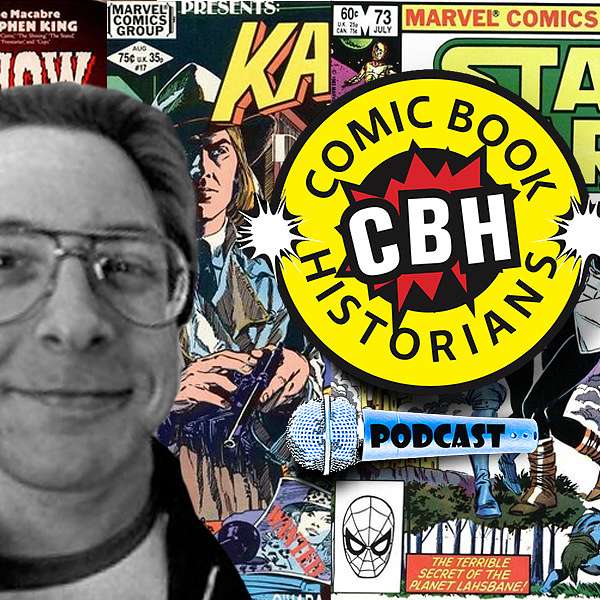
Comic Book Historians
As featured on LEGO.com, Marvel.com, Slugfest, NPR, Wall Street Journal and the Today Show, host & series producer Alex Grand, author of the best seller, Understanding Superhero Comic Books (with various co-hosts Bill Field, David Armstrong, N. Scott Robinson, Ph.D., Jim Thompson) and guests engage in a Journalistic Comic Book Historical discussion between professionals, historians and scholars in determining what happened and when in comics, from strips and pulps to the platinum age comic book, through golden, silver, bronze and then toward modern
Support us at https://www.patreon.com/comicbookhistorians.
Read Alex Grand's Understanding Superhero Comic Books published by McFarland & Company here at: https://a.co/d/2PlsODN
Series directed, produced & edited by Alex Grand
All episodes ©Comic Book Historians LLC.
Comic Book Historians
Ron Frenz: Marvelous Comic Artist part 1 with Alex Grand & Jim Thompson
Alex Grand and co-host Jim Thompson interview comic artist, Ron Frenz in a first of a 3 parter discussing his childhood in Pittsburgh,his favorite comics as a kid, meeting Marie Severin at a local convention, reading How to Draw Comics the Marvel Way by John Buscema, giving art samples to Jim Shooter at a later convention, his work in animation working on the Creepshow 1982 film, starting work at Marvel on Ka-Zar with Bruce Jones and Louise Jones, Star Wars with Tom Palmer, Marvel Team Up with Tom DeFalco and the beginning of his comics career on Spider-Man. Edited & Produced by Alex Grand. Images used in artwork ©Their Respective Copyright holders, CBH Podcast ©Comic Book Historians. Thumbnail Artwork ©Comic Book Historians.
Alex: All right. Welcome back to the Comic Book Historians Podcast, with Alex Grand and Jim Thompson. Today we have a very special guest, Mr. Ron Frenz, who’s been a comic artist since the early 1980s. Working with Marvel Comics, DC Comics, as well as various independent comics. Ron, thank you so much for joining us today.
Frenz: It is my pleasure to be here with both of you. Thank you very much.
Alex: Thanks. Ron, we’re going to kind of jump back and forth. Jim’s going to start on your early years. So, take it away, Jim.
Jim: Okay. So, Ron, you were born in February 1960, is that right?
Frenz: [chuckle] Boy, when you said early years, you’re not kidding, are you? Yes, I was born in a small 800-watt radio station in Pittsburgh, Pennsylvania… Yes, February first, 1960, that’s when it all started. Yes.
Jim: So, you and I were born within two months of each other. I’m going to be curious about what you were reading when I was reading, and things like that.
Frenz: Okay.
Jim: Now, you live in Bellevue?
Frenz: Yeah. I actually live a hop, skip and a jump from the hospital I was born in. I grew up in the north hills of Pittsburgh, 37 years ago, moved to a burrow called Bellevue. Which is hilarious when you work for people from New York, since Bellevue is a psychiatric hospital in New York.
Jim: Oh, sure.
Frenz: So, if you ever watch Barney Miller, they always talk about taking all the nut cases to Bellevue. So, if you’re working for people in an office in New York City, and you say you live in Bellevue, they love it.
But anyway, yeah, I’ve been living here my entire life, and I love it around here. I’ve thought about moving, more than once, but pretty much always came back around. Home is home.
Jim: And your father was a paper salesman?
Frenz: Yes, he was a salesman. He worked in paper products for decades. Actually, before he retired, he took a job with my brother’s home heating, fuel and oil company, and was selling home heating product and lubricants. But it was all selling. Yeah, he was a travelling salesman, basically. He had a fairly large area in West Virginia, and Ohio, and Pittsburgh.
We always had reams of paper around the house to draw on. And I think that certainly helped. I never had to draw on the walls, you know, that kind of thing, so yes. And my mom was a homemaker.
Jim: Did you ever go out on the road with him?
Frenz: No. I went to the office with him a few times, and made some runs with him when I was a real young kid. He would do that occasionally, when we had a day off from school or something. He was an incredibly personable guy. When I was growing up, he would always [chuckle]… He had a knack for calling people by nicknames. He would call people Skip or Pete. And when I was a young kid, I thought my dad knew everybody, until I started to realize, “Wait a minute. Everybody’s name is Skip or Pete?” You know, that kind of thing.
Jim: Now, that’s funny.
Frenz: Everybody thinks it’s about their dad, but he was one of a kind. He was a very personable guy and very successful as a salesman. So, yeah.
Jim: You mentioned your brother, you had a brother that was three years older than you. Was he kind of a launching pad for you to get interested in comics early?
Frenz: I would say that was probably the case. I actually have two older brothers, and a younger sister. And the oldest brother is 13 years older than I am. He’s virtually in a different generation. But yes, the brother, Randall, who’s three years older, that first comic book that I remember having around the house, that World’s Finest that I’ve talked about on my Facebook page, was a 1964 comic. I would have only been four years old; he would have been seven. So, I’m thinking he was responsible for bringing it into the house, more than I.
So, yes, I think we shared a passion for comics, but I would have to give him the nod on that. I would think my first exposure to comics were because of books that he was asking for, and not myself. Yeah.
Jim: Was there a point where he stopped reading comics and you kept reading them?
Frenz: I don’t think so. When he went off to college, I remember he took most of our DCs and I kept the Marvels. Because like a lot of kids, we started out on DCs, and discovered Marvel in the late ‘60s… Yeah, late ‘60s because I think my first exposure was probably the Spider-Man cartoon. It was in syndication in the mornings, and I fell in love with Spider-Man, and wanted to track down the comics, and the old Marvel superhero cartoons, and things like that.
There was a kid in our neighborhood that we would trade comics with, and he was already in the Marvels. So, I would get some Ditko reprints and everything, through that association.
[00:05:02]
Jim: Have you gone back and looked at those Spider-Man cartoons? Because once they bring in Ralph Bakshi, they get pretty crazy.
Frenz: They got really crazy. When they went in to syndication in the afternoons when I was in… I would probably have been about 14, 15. They were back in syndication in the afternoons, and that was when I realized, that there was that whole season that was more adapted from the comic books, and everything. The Grantray-Lawrence episodes before they handed it over to Bakshi.
I’ll be honest, the biggest memory I had from seeing them, in the mornings, in syndication was the Bakshi stuff. It was like the Origin cartoons, and some of the early ones with the King Pin and stuff. That was kind of what my memory was. So, it was really fun rediscovering that first season of episodes, and the nostalgia overwhelms me anytime I watch those. They’re wonderful. They’re weird but wonderful.
Jim: Yep. Absolutely. How old were you when you started to notice, with the comics… We’re you paying attention to the artist, or the artwork, and noticing the differences between different people?
Frenz: Almost immediately, I think, and of course my tastes have broadened since, but I remember, even as a kid, we were always disappointed when a Superman or an action comic had a Curt Swan cover but Wayne Boring inside art. We were recognizing the differences very early on. Of course, DC didn’t put credits.
I fell in love with the Aquaman cartoon in 1967 or eight, and so I was seeking out Aquaman comic books, and Nick Cardi was doing it at the time. I fell in love with Nick Cardi, almost immediately.

Jim: Oh, those covers during that period are just incredible.
Frenz: Yeah. And so, I was like nuts about Cardy. I mean, yeah… Once we discovered Marvel, and credits, and all of that, I knew I had my favorites, and would seek books out based on who was working on them and things. Yeah. Early on, we started when comics were 12 cents. It went from 12 cents to 15 cents, to 25 to 20, back up to 25. During that period of time, my brother and I, we were going to three different places, and spinning the spinner rack, and buying pretty much, every Marvel and DC comic.
Because we could afford to do that. I mean our dad was willing to. Our allowance was basically, that he would buy our comics every week. So that worked out great. We never had to… I mean, once they started to go up in price and… And certainly, once I was working in the industry, it was getting… Back in the days when they send comps and everything… But yeah, we were pretty abreast of everything. We didn’t really read war comics or westerns, as much.
At one point, I remember being of an age where I was embarrassed to buy romance comics, because Marvel was reprinting this stuff and it was John Buscema inked by John Romita, and Gene Colan inked by Sal Buscema. It was all these wonderful art team that you didn’t see on the superheroes, were doing these romance comics. And yet I was completely mortified to be buying a romance comic, like anybody cared, you know, that kind of thing.
Jim: Oh, I was buying Millie the Model. I was buying everything Marvel produced, the westerns, all of it.
Frenz: I wouldn’t… I can’t cop to that. Though I did become an Archie fan, and I’ll tell you, one of the things that prompted that was, when I was a kid, and I was drawing superheroes, I came to realize, that if I really wanted to do this for a living, I had to get better at backgrounds, I had to get better at cars, and horses. And I had to get better at drawing women. So, I was looking at a lot of Don Heck, and then I discovered the Archie Comics, and Dan DeCarlo, Harry Lucey, and guys like that who were fantastic at drawing women and keeping it simple. So, I started to pursue a bunch of back issue Archies just to learn how to draw girls.
Jim: I got hooked on Little Archie, and recognized just how fun that was. And then I just bought everything Archie had too.
Frenz: Well, I was never into little Archie. Even with the Archie stuff, I kind of have to cop to the cartoon helping to sell that too because in the late ‘60’s there was an Archie cartoon that kind of captured the feel of the Archie books at the time.
Jim: Sugar, Sugar.
Frenz: Yeah! Absolutely… When I was working on the Archie stuff within the last few years, it was always an interesting moment for me because I always kind of considered Archie, part of the big three. And when I was working on those couple of Archie stories, with Tom DeFalco, and I’d be sitting and listening to classic radio, and Sugar, Sugar would come on… It was one of those little moments that you know, it’s like, “That’s just so cool. I’m working on an Archie thing and the thing, and the sound from the… Gosh…” It was good. Neat… It was neat.
[00:10:04]
Jim: So how old were you when you decided you wanted to work for Marvel when you grew up, and draw Spider-Man?
Frenz: Pretty much upon… I drew constantly, so it was no surprise to anybody. By the time I was six or seven. By the time I’ve discovered Spider-Man, I would tell people that that’s what I wanted to do when I grow up. “I wanted to grow up, work for Marvel Comics, and draw Spider-Man.”
Jim: And what did you brother and your father say? Did they laugh or were they like, “Yeah, his good enough, maybe he will.”?
Frenz: My brother was always incredibly supportive, even when I didn’t really deserve it. He would sit and blow sunshine up my behind, that even at the time, I remember going, “Well he’s being very kind.” I was always pretty… I had an innate ability, I guess, to be pretty objective about my stuff. So, when I would try to copy something, or when I would try to emulate somebody’s style, my brother would be going, “Whoa, if that artist walked in here right now, he’d wonder, when did I draw that?” And I knew, he was being too kind.
[chuckle]
Frenz: I knew he was just being very supportive.
My dad, I don’t know what he thought about it. My mom was always incredibly supportive. My mom, on some level understood from very, very early on that somebody was getting paid to draw these things. They weren’t being produced for free… [chuckle] So she never… I never really had to suffer through criticism or doubts, or things like a lot of other illustrators have. I’ve heard the stories, and I was very fortunate. I never had to live with people telling me it was a pipe dream or anything like that.
Jim: When Spider-Man became your favorite character, who was drawing him at the time, Romita?
Frenz: Yeah. By the time I was buying new issues off-the-rack, it was Romita. I discovered Ditko in some of the reprints that I traded for with our neighbor’s stuff. And recognized immediately that a lot of the stuff from the old ’67 cartoon was taken off of Romita. A lot of the head shots and everything… I’m sorry, Ditko, were taken off of Ditko. I went, “Oh, that’s where they got that stuff.”
Jim: Oh, sure.
Frenz: But Romita was my first regular monthly exposure to Spider-Man. Yeah, it was in the 60s, the numbering of the books, it was like the late 60s. I remember the first one, I think the first Spider-Man I bought off-the-rack, new, was O Bitter Victory!, where King Pin is swinging Spider-Man around by his ankles, on the cover.
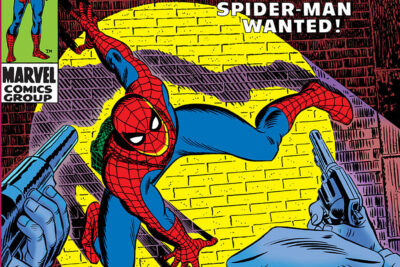
Jim: Oh, yeah.
Frenz: I think it was my first off-the-rack brand-new Spider-Man book, and just never looked back. Just loved every minute of it.
Jim: Those Romita covers, during his actual run, are really, really strong. I love some of those.
Frenz: They just… They went in your eyes and blew out the back of your head. That’s all there was to it.
Alex: Ha! That’s true.
Frenz: I was just completely, completely obsessed by seeing Romita, and Kirby, and Buscema, both Buscemas. I just I became probably as close to a Marvel zombie as you could find at the time. I was still enjoying DC stuff, especially Nick Cardi stuff. But yeah, I became a real Marvel devotee, yeah.
Jim: When Ditko went over to… Because I wasn’t aware of Ditko while he was at Marvel so much, until I was later exposed to Doctor Strange and stuff. But I was reading Creeper, and Hawk and Dove in real time, when they went over. Were you following that stuff?
Frenz: No. Unfortunately, I wasn’t, at the time. I would see the ads for Creeper, and Hawk and Dove in some of the more mainstream DC stuff I was reading. We’re already aware of Ditko on Doctor Strange because we got a whole bunch of the Marvel Tales giants, 25 cent Marvel Tales giants that ran Doctor Strange stuff. My brother, especially Rand, was deeply in to Doctor Strange. Still to this day, he is. It’s still one of his favorite characters.
So, we were aware of that Ditko stuff there through the reprints. And when he went over to DC, we missed Creeper almost completely. Hawk and the Dove, I was aware of through Teen Titans. I was always following Teen Titans, again, because of Nick Cardi. But I was aware when Ditko was doing Stalker, and some of that other stuff. There was a DC 1st Issue Special, where they tried to revive the Creeper, where he fought some lame villain called Firebug or Firefly, or something like that.
Jim: Yeah, and it just wasn’t the same.
Frenz: No. They couldn’t capture the same magic. I have since read the original Creeper run… It’s just ridiculously cool and weird, and wonderful. I love the characters.
Jim: Yeah, that first issue was just, that showcase issue, was just amazing, the origin story.
Frenz: Well, DeFalco and I were discussing doing a Creeper reboot with a DC editor.
[00:15:02]
But it was at a time when DC editorial was not interested in doing anything with the Creeper. It was right before they did that bizarre thing where he was like a Japanese or Chinese alcohol spirit or some stupid thing.
Jim: Oh. Yeah. That was awful.
Frenz: It was right before they did that in Katana, that we were told there was absolutely, positively no interest in doing anything with the Creeper. And then like a month later this Creeper shows up in Katana, and it’s like, “What are you people doing?”
We had some ideas that… They would have deviated from the original Ditko, but I was very interested in keeping as much of the Ditko aesthetic as possible.
Alex: Uh-hmm. Did you like the Ditko as much as the Romita?
Frenz: Yeah. I never pitted the two against each other, to tell you the truth. If you would have put a gun to my head on which books, I could keep, I probably would have gone with Romita. Because I maintain that, as fantastic, and quirky, and wonderful as Ditko was, I think when Romita took over the book, it broadened its appeal. Because Romita’s characters were more glamorous and more recognizable, and heroic.
And it’s possible. I don’t know this for a fact, in any way, shape or form, but it’s possible that the quirkiness of Ditko could conceivably, have held Spider-Man back, slightly. And when Romita kind of came on and opened it up, and brightened it up, and made it look a little more… I don’t know, like a… [chuckle] I’m really struggling with what words to use here without being insulting to either Romita or Ditko. But he made it to look more like a… Like what people were used to seeing in a comic book.
Alex: Right. A little more mainstream.
Frenz: And then it might have opened up its popularity, even more… But I don’t know that…
Jim: Let me ask you about some of the other Marvel artists of that time. Your impressions when you were a kid, when you were reading it at this age. You were aware of Kirby, what did you think of him and did you follow him when he went to DC?
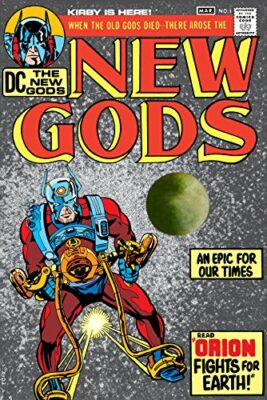
Frenz: We followed him when he went to DC because we were, again, still pretty much reading everything, and I loved his initial blast of books. I loved the Jimmy Olsen under Kirby. I loved the first Mister Miracle. To this day, that first issue of Mister Miracle was like burned on my brain.
We had a little bit of trouble getting all of the New Gods. We never got the first issue, we got the second issue, and them we missed… So, distribution wasn’t great, so we had some holes on our New Gods run. But we got all the Mister Miracles, and I love them. And Kirby is… I will cop to Kirby being an acquired taste.
When I was a kid, I liked Kirby and the energy of it that was there, all this kind of stuff. But anytime, like Buscema would do like a flashback to a Kirby scene, I always preferred the Buscema. You know, that kind of thing.
Jim: Oh, that’s interesting.
Frenz: I think Kirby is somebody that you appreciate more, as you become more educated, on what he actually was doing. Otherwise, you become caught up in how he draws fingers and how he draws knees, things like that. You’re absorbing the impact of the work, but you’re not really absorbing why. You’re more likely to look at the nuts and bolts to try to explain the whole, and that’s not how Kirby works. Kirby is impressionistic.
Jim: Were you paying attention to the inkers at this point?
Frenz: Yes.
Jim: Because I think, that’s when I noticed, “Ha! That doesn’t look like…”
Frenz: Yeah.
Jim: That’s Vince Colletta. That makes it different from when I was reading it with Fantastic Four.
Frenz: Oh, very much so. Very much so, yeah. I became pretty aware very early on of different artists and different artistic styles, and what inkers brought to the table. I was very fascinated. Any time I could find a fan magazine that would show pencil samples of things. I was very into that stuff. I had favorite inkers as well as favorite pencillers and stuff, yeah.
Jim: Who did you like inking on Kirby?
Frenz: I was a big Sinnott fan. When I was reading the regular stuff, and Marvel’s Greatest Comics, the initial run inked by Sinnott, I loved Sinnott. I was never a Colletta hater. I like what Vince would do for a lot of the stuff. I mean in that first issue of Mister Miracle, like I said, that was Colletta. Those early Mister Miracle, have a real feel to them that as much as I…
When Mike Royer came along, I was hooked. I loved the way he lettered. I loved the way he inked Kirby. I loved everything about the look of the finished book. I became obsessed with his display lettering. I just loved everything about Mike Royer.
[00:20:02]
But I never was a hater on inkers. I would notice differences, and I would notice if somebody didn’t really quite keep a Buscema face or something like that. But I was never really… I always recognized that comics was an incredibly collaborative medium.
I never trained myself with the inking tools, so I became, almost to the detriment of my development, I became aware that comics was very collaborative, and I wanted to pencil. I knew I wanted to be a part of the visual storytelling. And so, I knew I wanted to be a penciller, so I never really trained myself with the inking tools.
Even now, I’m only now getting confident in my inking ability, as far as it being a separate discipline from penciling. That kind of thing… And I just turned 60, so… [chuckle] I’m way behind the curve on that talent.
Advertisement
Jim: Me too. Let me ask you, real quickly, about a couple of others, and then we’ll get to your next stuff. What about Don Heck?
Frenz: I love Don Heck. My first exposure to Don Heck, were the Tales of Suspense, Iron Man Stories, from the old Iron Man cartoon. And I found those stories, like that first battle with Titanium Man, which was inked… I think a couple of chapters were inked by Wally Wood, but I think mostly was, it was like Esposito, I believe, if I remember correctly. And I loved Don Heck.
Again, he was never anybody that… I didn’t look at Don Heck and go, “He’s not as good.” I loved the energy that he had in there. As I’ve read about how things evolved at Marvel, I liked Don Heck, being Don Heck. Like when they gave him The Avengers, and he was trying a little too hard to be Jack Kirby. I don’t think it helped him, as much as… It might have helped him get work, but I don’t think it helped his work overall, to try to be something he wasn’t. You know, to try to keep Stan happy with the Kirby over the top action. I don’t think it served Don incredibly well. But those were early Iron Man stories that he did, that I was first exposed to, on the cartoon, are inked just incredible to this day.
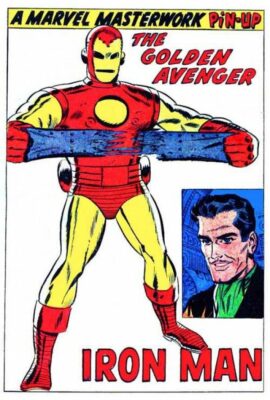
Jim: Those were great.
Frenz: Just amazing stuff. He was right there on my list of guys that I wanted to grow up and be, someday. Absolutely.
Jim: Oh, that’s great. And then last one, Gene Colan.
Frenz: The early Daredevil stuff he did with Stan, just made me laugh and entertained the hell out of me. Some of it, I was seeing in reprint. There was Marvel Triple Action or something, for a while, that they were reprinting the Daredevils. And the stuff is incredible. I had some early Daredevils off the racks. They might have been given to me by my oldest brother, I’m not sure. But it was beyond my 10, as far as some of the photo realism that he would get in there, and everything.
Jim: And you were still reading in the early ‘70s, when he was doing Tomb of Dracula with Tom Palmer too, right?
Frenz: I was reading all of that too, yeah. That first issue by… Vinnie Colletta, actually inked the first issue of Tomb of Dracula, and I was hooked at the end of the first issue… I kind of fell away from it later in the run, to my undying shame. But I was reading it from the beginning. That and Mike Ploog on Werewolf By Night… I was sampling all that stuff.
Jim: Man-Thing.
Frenz: Yep.
Jim: Yeah, that was great stuff. All right. So, you got a partial scholarship to go to the Art Institute of Pittsburgh. Was that straight out of high school?
Frenz: Yes. Yeah. The last two years of high school, I went to a vo-tech for half a day every day. Then joined an outfit called VICA, Vocational Industrial Clubs of America. Through joining VICA, they have regional and state competitions and coming in… Did I come in second or third? I think I came in third in the state, and won a half scholarship to the Art Institute of Pittsburgh.
I was able to complete the second year through grants and loans, and stuff but I went and I did the two-year course at the Art Institute of Pittsburgh. Which just recently closed down, after changing owners, how many times.
It did me a lot of good. During the two years in the vo-tech, I had a really good instructor, a gentleman named Tony Krum, who made me realize that it’s wonderful to have these dreams, but if you don’t get in to comics, you also don’t want to limit yourself. You don’t want to be just be able to do comics, and he kind of opened my eyes. So, the two years I spent at the Art Institute, I spent, trying to make sure that my stuff didn’t look like I was just comics taught. I started to pay attention to other techniques, and other ways of doing things, on the chance that my dream would be foiled or delayed, and I would have to get a job doing something besides comics for a while. I tried to pay attention to everything else.
[00:25:12]
And of course, that was all pre-computers. I’m incredibly old. And that was all pre-computers and we were still using Amberlith and Rubylith, cutting film for overlays of the different color separations, and all kinds of hands on stuff that nobody in the industry does anymore.
Jim: You met Marie Severin before you met Jim Shooter when you showed him the Xeroxes, right?
Frenz: You guys certainly did your research… Yeah. There was a local comic convention and she was one of the guests, and I took a stack of stuff, again, it wasn’t… They weren’t page samples, they were just loose drawings of dynamic figure work and characters that I had created, and things like that.
She was incredibly wonderful. Took a lot of time, as she was with everybody, looking through the stuff, and giving opinions. She liked my stuff enough that she wanted me to take it to Jim Shooter and get a sample plot, to really start working on storytelling, and everything. She had irrational confidence in my ability to do it, based on what she had seen in the drawings.
But I chickened out that year. It wasn’t until I was in the Art Institute that was in downtown Pittsburgh, and Jim Shooter was appearing at a shop within walking distance of downtown Pittsburgh; doing autograph signings, and stuff because that’s his home turf as well. A couple of buddies of mine and I put together some samples.
I came very close to chickening out there too. But my friends were very supportive, and said, “If you don’t show him your samples, we’re going to kill you.” So, I showed him samples. By that time, I had done some storytelling. I had taken some stories from a friend at the Art Institute. I did his own character, The Pariah, that involved mercenaries, South American jungles and things like that. We did an origin story for him. Those were the pages that I showed to Jim Shooter, along with a three-paged Spider-Man sequence from FOOM magazine. And he was amazing…
Jim: I’m curious about that. What was that?
Frenz: What? The Spider-Man?
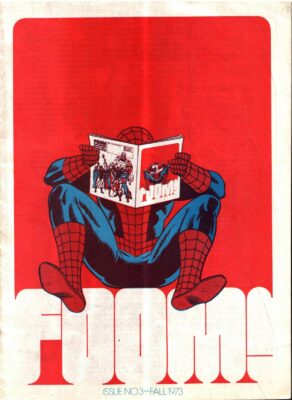
Jim: The FOOM, was that something you copied? Or was that something you drew for FOOM?
Frenz: It was… FOOM was their fan club for a while, Friends of Old Marvel, F-O-O-M.
Jim: Right.
Frenz: And they, at one point, in one of their magazines, printed a three-paged sequence. It was for some kind of a contest, I think. They printed three pages of a plot of Doctor Octopus has Ned Leeds and Betty Brant hostage, and Spider-Man is fighting the Rhino and Green Goblin, I think or something. I just took that from the magazine, not to do the contest but just to do the pages, working off of somebody else’s plot.
I look back on this stuff now, and obviously, Jim Shooter saw something in it that he can work with, and said that he would give my name to editors, and that I’d be hearing from them. And I walked out of there thinking, “Holy crap. That’s amazing.”
It was a year before I heard anything. But I did end up hearing from them. I’d already taken a job at Anavision, an animation house in Pittsburgh that worked on local and regional TV commercials, and we also worked on the two Creepshow movies. [crosstalk]
Jim: Yeah, I have a question about that, just a few. But I wanted to nail you on the timeline. When you met with Marie Severin, were you already out of the Art Institute, or were you…?
Frenz: No. I was still in high school when I met with Marie.
Jim: Okay.
Alex: What year would you say that was, when you met her?
Frenz: Well, I graduated high school in ’78, so I would say that was probably ’77, ’78, something like that.
Alex: Oh, okay.
Frenz: So, meeting with Shooter wasn’t until towards the end of art school. Art school, I guess, would have been ’79, ’80 or ’79, ’81.
Jim: Yeah.
Frenz: Something like that. I think my first published work, that first Ka-Zar stuff I think was end of ’82, ’83, something like that.
Jim: Yeah, that’s right. ’83.
Alex: Was the book, the John Buscema, How To Draw Comics The Marvel Way, did you read that before you were submitting your stuff?
Frenz: Oh, yeah. That was one of my Christmas gifts one year. I went through that until pages were falling out of it. I did two stories for a magazine that was published here out of Pittsburgh called Questar Magazine. This would have been when I was working at the animation studio. They were on the floor below us, their offices. I had shown them some samples, they were aware of my work up in the animation studio.
Frenz: They had a strip in their magazine called, Just Imagine, Jeanie that was originally created by Forrest J. Ackerman, and was originally drawn by… Oh, man, this is embarrassing. What’s the guy’s name who did the soup can and everything?
[00:30:13]
Jim & Alex: Andy Warhol.
Frenz: Andy Warhol. His brother, James Warhola, did the art on the first Just Imagine, Jeanie strips. Okay.
Jim: Wow
Frenz: They lost Warhola early on. They lost Forry J Ackerman early on, as far as contributing to the strip. But at one point, they had a local writer doing the scripts, and Mike Grell did a couple of installments for them. And then, they had just recently lost Mike Grell, to other work and everything, and they asked me if I was interested in taking it over.
So, the first published comics work I did was for this Questar Magazine. This Just Imagine, Jeanie episode that I penciled, inked and lettered myself. It looks like it. One of the reasons I bring it up, is because there are panels in there that are lifted directly out of How to Draw Comics the Marvel Way.
Alex: Wow.
Frenz: So, that was my bible, and my crutch, as I was first getting in to doing published work. And then the second installment I did of Just Imagine, Jeanie, was in full color, and I lettered it, and colored it myself with markers and stuff, for full color publishing.
That was very bizarre too because the guy I worked with at the animation studio, my boss there, Rick Catizone had introduced me to different illustrators and stuff… I’m trying to remember the one gentleman’s name and I’m not coming up with it. But there was that, and I was going through… In art school, I went through a big Gene Colan phase where I was trying to re-create some of the dynamics of Gene Colan’s work.
There was a weird mix of stuff going on in my brain at the time. But those would have been my first two published pieces… And what can I tell you…
Jim: Let me ask you a little bit about Anavision.
Frenz: Okay.
Jim: You mentioned Creepshow. What were you doing on the first one, the 1982 one? What were you doing, were you doing storyboard? Were you working on animation scenes?
Frenz: I was hired, in general, based on my portfolio, that I could draw from memory, and that I had a solid grasp on anatomy and things like that, without having to use much in the way of reference. He used me initially, for some storyboarding. He used me for inbetweening, which is exactly what it sounds like. He does all the key drawings and I do the drawings in-between. That’s kind of what I did on Creepshow.
The original Creepshow, we did some stuff on colored paper. The scene where they pull the camera back and the Creep flies back and points down at the garbage can, and we come in on the comic book and everything. That was all done on colored paper, with colored pencils, the backgrounds were… There was all kinds of different media being used in that, but the only artwork of mine that you see in the first Creepshow, directly, are the opening credits, and the Creeps had to be inserted into some of the splash pages.
One of the original EC guys did the pages, the transition pages for the first movie. But when they decided to use the Creep, as the host, we had to rejigger some of the splash pages, and kind of stick the Creep in there as the host, and I did some of that art.
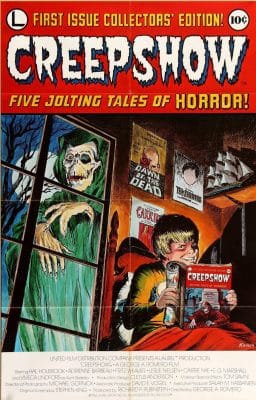
Alex: Nice. So, when you say original EC guys, did you mean Jack Kamen?
Frenz: Yeah. Yeah.
Alex: Yeah, okay.
Frenz: They brought him out of retirement to do the original transition pages and stuff, yeah.
Jim: That’s great. There’s some stuff online, that’s described as ‘try out’ things from you from that. Do you know what that was?
Frenz: Yeah. Those were marker renderings I did early on when we were just seeing the beginning of the script. My boss wanted me to do… Basically, audition to do the transition pages, and stuff, which didn’t happen because they were able to get a hold of Jack Kamen. So, yeah, that was that was. It was like the splash page for The Lonesome Death of Jordy Verrill. I think I did one for the end of Father’s Day or something.
Jim: The birthday one.
Frenz: Yeah, the birthday one.
Jim: Yeah, it was the birthday one.
Frenz: Those were heavily influenced by… My boss was pointing me towards Bernie Wrightson and all this kind of stuff. We were trying to basically do as much of it in-house as we could possibly could. And actually, for the second one, we ended up doing that. I did do all the pages, and transition shots and everything for the second one.
Jim: And that was years later, right?
Frenz: Yeah. At that point, I wasn’t working full time at the animation studio. I came back to do that.
Jim: I was wondering about that. Because that was several years later. Did you do anything else while you were at Anavision that was interesting? I know they did Tom Petty video, Runnin’ Down A Dream. You didn’t work on that, did you?
[00:35:01]
Frenz: I think I was pretty much gone by then too. There was like one sequence involving the sequence where he’s on the building, like King Kong or something, that I did a couple of drawings for. But I wasn’t as involved in the production stuff then. Like I said, I think I had moved on. I quit the animation studio when they offered me Spider-Man.
Frenz: During the time I was at the animation studio, I was working full time at the animation studio, and that was during the time I was doing Ka-Zar, I did the two Indiana Jones fill-ins, my run on Star Wars, and my run on Marvel Team-Up, were all done while I was also working full-time at the animation studio.
Alex: Kind of getting now to Marvel, you had given Jim Shooter those pages, and then, I think some time had gone by, maybe a year, possibly.
Frenz: Yes. All that work, I was working in the animation studio for almost a year when I got a phone call from my mom. I was still living at home, and she said, “Somebody named Al Milgrom called from Marvel, and wants to talk to you.” I went, “Really… Okay.” So, she gave me the number, and I called, and I talked to Al Milgrom, and he handed the phone to Louise Jones, and that’s how I got those first few Ka-Zar jobs. Yeah.
Alex: Yeah, and that was Ka-Zar #17, it was a fill-in issue, right? And how did that work? Did they work Marvel style, like give you a plot?
Frenz: Well, Bruce Jones never did anything traditionally. So, my first exposure to working for Marvel wasn’t really working Marvel style. Bruce Jones would write these little short stories with no page breakdowns or anything. And it was your job to translate that into pictures. So, it was a very different thing from even working off a traditional Marvel plot. But with Louise there to hold my hand, and walk me through it, I did what I was told.
I actually did #17 first, which was a very bizarre story where… What is it? Like Ka-Zar thinks he’s in a detective novel or something like that. I forget how that happens. He gets a concussion or something like that.
Jim: Yeah, the cover says Ka-Zar the Detective on it. I remember it well, because it was different.
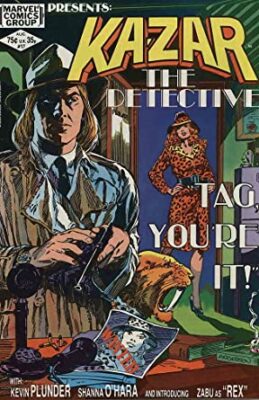
Frenz: Yeah, he’s altered somehow, I forget exactly what happens in the story, but he’s altered and thinks he’s living a detective novel that he was reading.
It was a test. I don’t know if I served the story incredibly well, but got to the end of that one, and turned it around fast enough that they said, “Well, we have issue #16 that we’d like you to do.”
Alex: Right, “Can you do that one next.”
Frenz: “It’s a little tighter deadline”, and I went, “Okay.” That one was more traditional, in the jungle, fighting monsters and things like that, so I was much more comfortable with that one.
Alex: As far as jumping around in the jungle and just kind of anatomic action hero… How did you feel about that? About a character jumping around the pages that way.
Frenz: Well, that’s what I was comfortable with. I mean, anytime, you can just do the human figure in motion, with a manageable background like a jungle setting or something like that, I think it’s faster. The thing with the detective novel was that the detective sequences were supposed to be set like in the ‘30s, and were supposed to be more noir, and those were the kind of aspects that I’m not sure I served as well as I could have.
Because these was before the internet, and you had to really dig for reference for different things back then. That’s why I’m not sure I served that particular aspect of the story all that well. But I think most of us would admit, most freelance illustrators that work in comics would admit, that if you gave us two guys in skin tight costumes fighting each other in a white room, that would be our ultimate story. [chuckle]… You know what I mean.
Alex: Yeah. That’s the easiest thing.
Frenz: If you don’t have to worry about background, if you just got to draw dynamic figures beating the crap out of each other, that’s our sweet spot.
Alex: That’s, yeah, for sure.
Frenz: Anything else is taxing us in one direction or the other.
Alex: Right. Was there any uncredited Marvel work before that or it pretty much starts at Ka-Zar?
Frenz: It pretty much starts at Ka-Zar. I did not start out ghosting for anybody, or doing backgrounds for anybody, or anything like that. No.
Alex: Then you did breakdowns for King Conan #12, is that right?
Frenz: That is correct. That was the third thing I did for Louise, and interestingly enough, after I did that, they offered me King Conan as a regular gig. But, again, still working at the animation studio, and that being a double sized story… It might have been bi-monthly, I’m not sure. But I remember being very gun-shy to take a regular gig at that point. I was happy doing whatever they wanted me to do, but I was a little unsure about going on a regular gig. So, I turned down King Conan.
Advertisement
[00:40:06]
And then, a little while later, they offered me Ka-Zar. Brent Anderson decided he was leaving Ka-Zar, and they offered me Ka-Zar. At that point, God’s honest truth, I probably would have rather done Conan, than that version of Ka-Zar, but that horse was already out of the barn. But at that point, when they offered me Ka-Zar, I was afraid that if I don’t take this, they’re going to stop offering things. So, I took it. And that’s how my stint on Ka-Zar happened.
Alex: That’s how it started. Yeah. Were you looking at any Tarzan stuff, just for kind of reference?
Frenz: No, not Tarzan. I was a huge Buscema fan, so I had all of his black and white Ka-Zar stories from that Savage Tales that they were running in the ‘70s.
Alex: I got you.
Frenz: That was the stuff I was looking at; I think the most. Even with Shanna, I was looking at some DeZuniga black and white stories that he did with Shanna. For the most part, my reference for my stuff on Ka-Zar was mostly the black and white Ka-Zar stuff and not even the colored stuff that Buscema did.
Alex: Right. Yeah, the black and white magazines. So, then you started doing, again, more non-superhero stuff, it was Star Wars, Indiana Jones, Marvel Saga. How did all that come about?
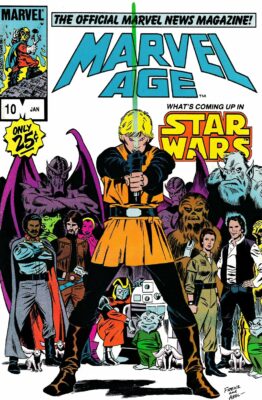
Frenz: Just the way things do. People see that you’re hitting your deadlines and see the work that you’re doing, and think you might be okay for this… Indiana Jones, again, was out of Louise’s office. Star Wars was out of Louise’s office. So, at that point, I was just one of Louise’s guys, and she was kind of using me as the utility guy for fill-ins and such.
The first thing I did for Star Wars was a framing sequence for a Kerry Gammill inventory story that they had, with Archie and Walt moving off the book, and they were bringing in Mary Jo as the scripter. Mary Jo, I guess, probably, as a floater, as a test balloon, had done an inventory with Kerry Gammill. Of course, they had worked on Power Man and Iron Fist together, or would. I don’t know, maybe it’s… I guess, they had already.
But anyway, they had this inventory story, and they needed a few pages to fit it in the continuity. So, that was the first thing I was asked to do for Star Wars, before they offered it to me. I was a big Star Wars fan. I loved Luke Skywalker, so that was a lot of fun for me.
The only postscript I would put on the Ka-Zar stuff is that I was a huge fan of Ka-Zar, prior to the Bruce Jones stuff. And while I appreciated what Bruce Jones was doing with the character and that he was getting a lot of response from the readership, I didn’t think Ka-Zar needed to be fixed. And I was constantly behind the scenes, begging Louise Jones to, “Could we do a story that bridges how the Ka-Zar I remember so fondly from the old Ka-Zar stories became this Ka-Zar.”
Alex: Right.
Frenz: And Louise, thinking like an editor and not being worried about one fan crying in the wilderness was going, “Ron, nobody cares.” [chuckle] “This book is selling. We’re doing fine.” And I said, “But, you know… “ At one point, there was even a reference, where Shanna was talking to Peter Parker, which is again, I got to do Spider-Man, and Ka-Zar as well. She was talking to Peter Parker and said something about Ka-Zar struck her at one point and he goes, “Ka-Zar hit you?” and she goes, “Yeah, all apes hit their mates.” … And I’m like, “He’s not an ape man. He was raised by Zabu. He’s a feral child but he’s not an ape man.”
Alex: That’s funny.
Frenz: And one scene, where he’s fighting the monster, in my second issue, I liner noted, “Stronger than the mastodon. Stronger than the giant boar, Mightiest Ka-Zar, Lord of the Jungle.” That was his thing, man. And I liner noted that, and they completely ignored it. I’m going, “Oh, you’re killing me.” That would have been a nice little bridge from the guy I knew, to this guy.
Alex: Yeah. Yeah.
Frenz: It was one of those situations where they just weren’t recognizing that the old Ka-Zar had any fans. It was frustrating but I certainly understood where Louise was coming from.
[crosstalk]
Alex: Did you have a favorite inker at this time? Like did you like Tom Palmer’s inks on your stuff?
Frenz: Well, Tom Palmer, yes. I mean, anybody would love Tom Palmer. I liked what Armando Gil did over me for the most part. What I remember about Armando, at the time is that he really wanted to pencil. And we had a couple of issue from him that were a little more slapdash than others. For the most part, he did beautiful, beautiful, beautiful work.
But we had a couple of issues where the editor wasn’t as happy with what he was producing. But she knew it was because he was frustrated and he wanted to pencil. And when I left the title, he penciled, I think maybe one or two issues, before he realized penciling is really hard. [chuckle] And he decided that he was done already.
[00:45:00]
I mean, Armando left comics. I don’t know what he’s doing now. I mean, he’s a hell of an illustrator, so I hope, whatever he’s doing, he’s happy but…
Alex: That’s cool.
Frenz: I enjoyed working with him. I liked him.
Alex: You were doing all these from Pittsburgh, right? So, you would essentially mail your stuff in.
Frenz: Yeah. A lot of shipping to the post office, and/or FedEx. Yeah.
Alex: So, at this point, were you wondering like, “Okay, am I ever going to draw superheroes? Was that your personal genre?
Frenz: I was scared. I was scared that I was not going to get to do the superheroes. It was one of those things like, “Okay, I’ve shown them that I can function outside the superhero genre, but there is nothing I want to do more than superheroes.”
So, when Spider-Man showed up in Ka-Zar, I was happy as a clam, and I got to do some Spider-Man. Tom DeFalco was the editor for Team-Up at the time, and he saw the Spider-Man I did in Ka-Zar, and thought, “Well, this guy doesn’t screw up Spider-Man too badly, so maybe I can give him some fill-in stuff.”
I did an inventory issue of Marvel Team-Up, which led to me being hired as the regular artist on Team-Up. But they didn’t seem to like it because it was broken up with fill-ins, and then the team shifted pretty quickly to DeFalco giving up his titles and handing them to Danny, that was when I was hired to do the regular book.
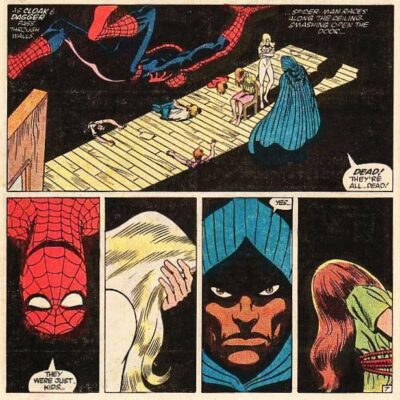
Alex: You were doing the Marvel Team-Ups, you worked with writer Bill Mantlo, right? On a few of those issues.
Frenz: Yeah.
Alex: How was his style of collaboration with what you guy were working on?
Frenz: He was doing much more traditional Marvel plots. So, I was thrilled, finally working on traditional Marvel plots. Jo Duffy did traditional Marvel plotting, and did some page breakdown and stuff, which was very helpful. And Jo really got me used to the traditional Marvel collaboration. Where she would plot it to a point where you felt confident with what you were doing visually, and then she enhanced that with her script. I enjoyed working with Jo immensely. I learned everything I know about partnership and checking your ego at the door, and trusting your partner, I learned from Jo.
Because I never really had interaction with Bruce Jones on Ka-Zar. He turned in his little short stories, And I did what I did with them, and that was pretty much that.
So, when I was working with Mantlo, I don’t believe I ever had a phone conversation with Bill or anything. Because I didn’t really work on enough of his stories for it to matter. But it was work in traditional Marvel plot so it was what I had become used to with working with Jo. It was fairly seamless. I mean, I don’t remember the stories that I did with him being a problem of any kind. He put a lot in to his stories. You got your money’s worth if you were paying Bill Mantlo for a plot. Because I remember the Kitty Pryde one I did had a lot of story to it.
The Wonder Man one I did was, I think, David Michelinie. The Jack of Hearts one was, of course, Bill Mantlo. That was his baby.
Jim: Was that a pain to draw? Jack of Hearts?
Frenz: No. I loved that character. I love that outfit.
Jim: Yeah, I do too.
Frenz: Once you draw it once or twice, you get the pattern down and it’s not a problem at all. I’ve never really understood people complaining about that. I mean, the same people that complain about Jack of Hearts are the ones that complain about Spider-Man’s webbing. It’s like, “Oh, boo-hoo. Draw the damn webbing.”
[chuckles]
Frenz: If I had to complain about anything with Spider-Man, is drawing New York City. [chuckle]
Alex: Yeah. That’s a lot.
Frenz: Every third panel you got to do a cityscape. That’s where you complain about Spider-Man, not the webbing.
Alex: There you go. And that’s funny, I haven’t heard that before, but that does make sense… So then, you did the work on Ka-Zar and Spidey Team-Up, and then DeFalco saw your rendition of Spider-Man… So, was it that there was this feeling of, “Okay, there’s like a Romita-Buscema vibe to this Spider-Man”, and that resonated with DeFalco, probably?
Frenz: I think so… I think so, yeah. By the time I was a couple of issues in on the Ka-Zar stuff, immediately, I was fairly comfortable doing a kind of a Sal take on Spider-Man. Yeah. I think they saw it as being pretty standard for what was going on at the time, and it was safe enough to hand it over. Of course, what they didn’t suspect, until The Kid Who Collects Spider-Man, which I did before I was awarded this series. What they weren’t expecting was that, if I got to do more Spider-Man, I was going to pull out my Ditko. [chuckle]
So, when I turned in the pencils on The Kid Who Collects Spider-Man, there was some consternation, about some of the reverse webbing on the mask and all that kind of stuff. There were some consideration about having it fixed. And this was all pre-Todd McFarlane, of course. And they didn’t. To their credit, they didn’t fix it and it landed pretty well with the audience. It was a fantastic story. That’s all due to Roger. All I had to do was stay out of the way, and let the story tell itself.
Alex: Right… Once you then got offered Spidey, as a regular gig, that’s when you decided to leave Anavision, right?
[00:50:01]
Frenz: Indeed. I sat down with my boss, and had a long conversation with him. Freelance is freelance. But through paying my taxes, those couple of years that I was doing both, it became clear that working in Anavision was kind of paying the taxes on what I was doing for Marvel. And that even though I would be freelance, if they were offering me a regular monthly title, that’s about as stable as you get in the comics industry, and they were offering me the Amazing Spider-Man. So, unless I screwed up…
I thought about turning it down, because I didn’t think I was ready. But then it occurred to me that I could be relied upon to give 110% to what I was producing, because of my love of the character. It would’ve been hard for me not to take it and then whoever did take it, kind of watch them… [chuckle] do those stories. You know what I mean? I don’t think I could have survived that, to tell you the truth. So, I closed my eyes and jumped, and said yes.
Alex: Nice.
Jim: Ron, I want to clarify a couple of points about that. You were initially hired to fill in for John Romita, Jr while he set up X-Men, right?
Frenz: That is true.
Jim: And you were going to do like six issues.
Frenz: That is true.
Jim: Now, was The Kid Who Collects Spider-Man one of those six issues? Or did that come before…
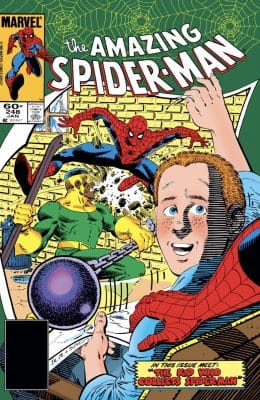
Frenz: No… That was prior. That was prior. I had also done…
Jim: You were being offered…
Frenz: No. I was never offered Spider-Man like, “Would you like the book?”, until we were a few issues into the run. And it became clear that JR had had a conversation with Danny, and decided that he wasn’t coming back and go ahead and give it to us.
Jim: All right, so you didn’t leave the animation studio until you knew that you had the on-going gig or…
Frenz: No, the idea that they were offering me Spider-Man work was making me feel like, “Okay, I can do this.
Alex: There you go.
Frenz: It was their masthead character, for god’s sakes. So yeah, at that point, it was supposed to be a six-issue run but I had no reason to believe that I wouldn’t be safe on like Marvel Team-Up, or something else. Because I’d already done a What If Spider-Man, and I’d already done a What If with the FF, working with Sinnott. I mean, there was just all these… I was becoming more and more useful to them. Some of which through, I was able to turn around breakdowns quickly. I mean, they pretty early on shifted me to breakdowns because they liked my storytelling, and were more concerned with getting these books laid out, and on to the inker and stuff.
So, for the longest time, I thought, that would be my role. I would be kind of like a Utility Sal guy. You know, that kind of thing. And I was fine with it, but I had every reason to believe that that would lead to more work.
Alex: Well, thanks so much, Ron Frenz, for this awesome interview here at the Comic Book Historians Podcast with Alex Grand and Jim Thompson. Join us next week for part two of the Ron Frenz’ career interview.
© 2020 Comic Book Historians
